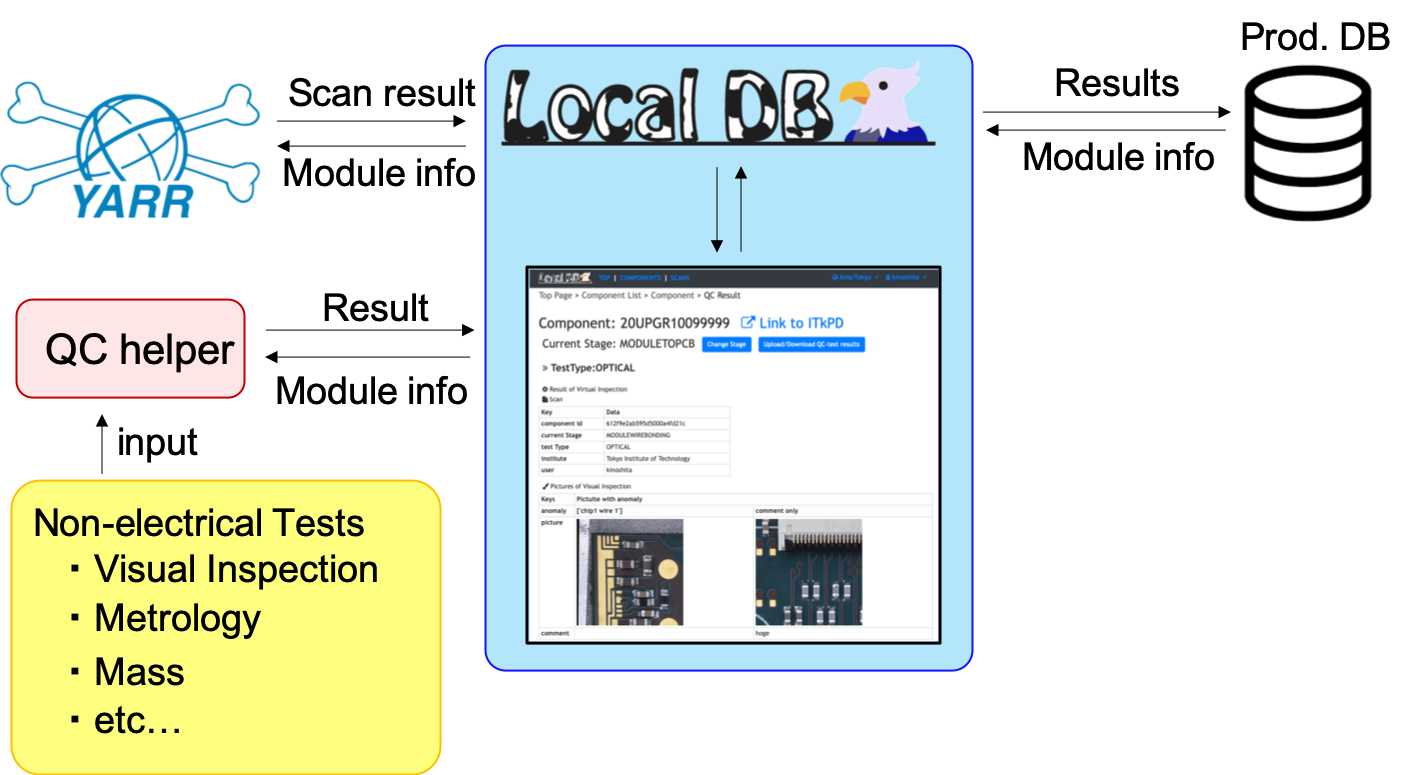Top Page¶
General¶
The LocalDB is an intermediate aggregation place of the data of a QC site/cluster for module QC during the production, designed to support concurrent production and tests of ITk modules over various sites.
It aggregates and organizes all electrical and non-electrical test results sourced from various PCs or devices in the lab. LocalDB supports module QC and its pre-defined tests and stages, which are parts of the waterflow of the production defined in the ITk production DB. It refers to the ITk production DB to load or generate module/FE serial numbers.
For electrical scans, it runs a high-level analysis process (e.g. bad pixel analysis) to synthesize a suitable format to upload to the production DB. The site administrator can select adequate scans to be submitted to production DB.
The LocalDB can download test results of a module from the production DB and can offer to compare the results between different stages over sites. In this view, typically it is natural to allocate one LocalDB service per site in our production model.
Overall Scheme¶
Production DB: A central DB for ITk,setup in Czech.LocalDB viewer: A web application to manage module QC.QC-helper: A GUI to upload non-electrical test.
MongoDB¶
The backend database service of the LocalDB system is MongoDB. It is highly flexible for storing JSON-like NoSQL documents, but it also enables to relate documents. LocalDB makes use of MongoDB features effectively. The PC should allocate up to several TB of the disk storage for the MongoDB service, assuming around 1GB is consumed per module for storing the tests of all stages. The necessary capacity would depend on the number of modules produced at the site. The LocalDB data can be synchronized to an independent MongoDB service to support backup.
Note
For CentOS7 installation, MongoDB v4.2.21 is installed by default. MongoDB version 4--7 have been tested to work. For more info on the compatibilities see https://www.mongodb.com/docs/languages/python/pymongo-driver/v4.8/reference/compatibility/
QC tests and LocalDB¶
Two frameworks exist to upload test data to LocalDB.
-
The
YARRsoftware, which is used for controlling ITkPix FEs and running scans, is native toLocalDBto upload scans. -
In order to support uploading generic non-electrical scans, e.g. IV scans, metrology, optical inspection etc., the
QCHelperGUI (based onPyQt5) is the central interface. It interacts withLocalDBto properly format all non-electrical test results under a genericJSONformat and upload them toLocalDBas tests.
For downloading results and configurations of scans to a local host, the YARR software contains the so-called LocalDB retriever CLI. In addition, the LocalDB Viewer browser provides various buttons to download specific data manually.
Handling of time-series data in LocalDB¶
In parallel to electrical scans, the DCS time-series data (e.g. temperature, current, voltage) needs to be associated as an auxiliary information. We generally assume influxDB is the default system to store such a time-series data monitored in the lab. However, LocalDB itself does not store the time-series data: only a clipped snapshot of such data can be associated to each electrical scan. Such clipping task is not done within the LocalDB server side, but it is a task to be done as a post-process of YARR scans.
Warning
The underlying data scheme between InfluxDB 1.x and InfluxDB 2.x is different and not compatible. The current LocalDB system is only adapted to InfluxDB 1.x. Inclusion of InfluxDB 2.x is a future ToDo.
Host specs¶
This service host can be a standalone workstation. Typically we assume the same host is used as an HTTP server of LocalDB Viewer, the user's browser interface frontend for module QC production operation. For smoother operation, the admin should make sure accessibility to this HTTP service from other hosts of the site, or if required, from other sites.
Though it is possible, we do not generally assume that the LocalDB host equips the YARR hardware. In this documentation we assume the LocalDB host is a separate host PC from those used to run scans.
OS support¶
We officially support CentOS7, CentOS Stream 8 and Alma 9 Linux system in this document as the default operating systems. One should be able to install the service to macOS, but it should be the user's responsibility to setup.
